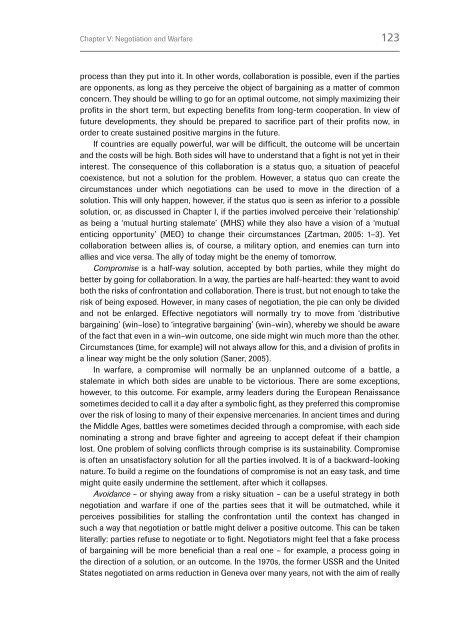Diplomatic Negotiation
Diplomatic_Negotiation_Web_2015
Diplomatic_Negotiation_Web_2015
You also want an ePaper? Increase the reach of your titles
YUMPU automatically turns print PDFs into web optimized ePapers that Google loves.
Chapter V: <strong>Negotiation</strong> and Warfare<br />
123<br />
process than they put into it. In other words, collaboration is possible, even if the parties<br />
are opponents, as long as they perceive the object of bargaining as a matter of common<br />
concern. They should be willing to go for an optimal outcome, not simply maximizing their<br />
profits in the short term, but expecting benefits from long-term cooperation. In view of<br />
future developments, they should be prepared to sacrifice part of their profits now, in<br />
order to create sustained positive margins in the future.<br />
If countries are equally powerful, war will be difficult, the outcome will be uncertain<br />
and the costs will be high. Both sides will have to understand that a fight is not yet in their<br />
interest. The consequence of this collaboration is a status quo, a situation of peaceful<br />
coexistence, but not a solution for the problem. However, a status quo can create the<br />
circumstances under which negotiations can be used to move in the direction of a<br />
solution. This will only happen, however, if the status quo is seen as inferior to a possible<br />
solution, or, as discussed in Chapter I, if the parties involved perceive their ‘relationship’<br />
as being a ‘mutual hurting stalemate’ (MHS) while they also have a vision of a ‘mutual<br />
enticing opportunity’ (MEO) to change their circumstances (Zartman, 2005: 1–3). Yet<br />
collaboration between allies is, of course, a military option, and enemies can turn into<br />
allies and vice versa. The ally of today might be the enemy of tomorrow.<br />
Compromise is a half-way solution, accepted by both parties, while they might do<br />
better by going for collaboration. In a way, the parties are half-hearted: they want to avoid<br />
both the risks of confrontation and collaboration. There is trust, but not enough to take the<br />
risk of being exposed. However, in many cases of negotiation, the pie can only be divided<br />
and not be enlarged. Effective negotiators will normally try to move from ‘distributive<br />
bargaining’ (win–lose) to ‘integrative bargaining’ (win–win), whereby we should be aware<br />
of the fact that even in a win–win outcome, one side might win much more than the other.<br />
Circumstances (time, for example) will not always allow for this, and a division of profits in<br />
a linear way might be the only solution (Saner, 2005).<br />
In warfare, a compromise will normally be an unplanned outcome of a battle, a<br />
stalemate in which both sides are unable to be victorious. There are some exceptions,<br />
however, to this outcome. For example, army leaders during the European Renaissance<br />
sometimes decided to call it a day after a symbolic fight, as they preferred this compromise<br />
over the risk of losing to many of their expensive mercenaries. In ancient times and during<br />
the Middle Ages, battles were sometimes decided through a compromise, with each side<br />
nominating a strong and brave fighter and agreeing to accept defeat if their champion<br />
lost. One problem of solving conflicts through comprise is its sustainability. Compromise<br />
is often an unsatisfactory solution for all the parties involved. It is of a backward-looking<br />
nature. To build a regime on the foundations of compromise is not an easy task, and time<br />
might quite easily undermine the settlement, after which it collapses.<br />
Avoidance – or shying away from a risky situation – can be a useful strategy in both<br />
negotiation and warfare if one of the parties sees that it will be outmatched, while it<br />
perceives possibilities for stalling the confrontation until the context has changed in<br />
such a way that negotiation or battle might deliver a positive outcome. This can be taken<br />
literally: parties refuse to negotiate or to fight. Negotiators might feel that a fake process<br />
of bargaining will be more beneficial than a real one – for example, a process going in<br />
the direction of a solution, or an outcome. In the 1970s, the former USSR and the United<br />
States negotiated on arms reduction in Geneva over many years, not with the aim of really


